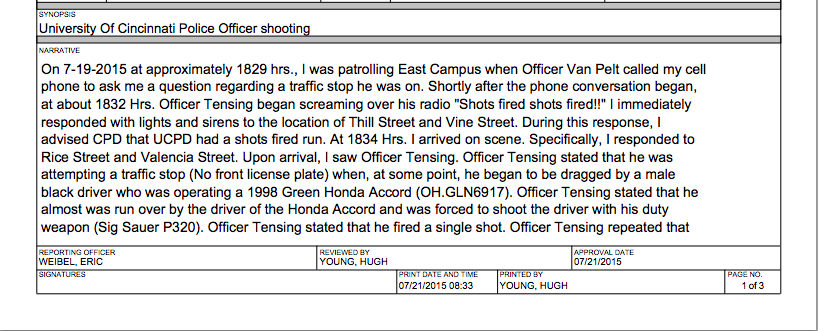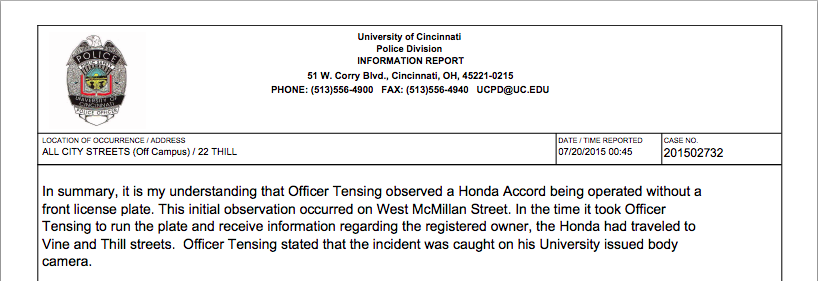We Compared the Sam Dubose Police Report to Body Cam Footage

By:
In the University of Cincinnati's ongoing effort to remain transparent about the circumstances surrounding the death of Sam Dubose, who was shot and killed by a campus police officer on July 19, the university published a copy of the police report online, along with links to the body cam video and several official statements. What a reading of the police report reveals is a pattern of lies and half-truths, handed down by at least two officers, that do not appear to hold up when compared to the footage of the shooting released on Wednesday.
Those other officers that arrived on scene, Officers Phillip Kidd and David Lindenschmidt, were placed on paid administrative leave on Thursday because "an internal investigation is now underway," the NBC affiliate WLWT reported.
Ray Tensing, the former campus police officer who killed Dubose after pulling him over for driving without a front license plate, claimed that he shot the unarmed Black man out of self-defense—that Dubose attempted to drive away, dragging the officer along with him. The former officer was indicted for murder, and at his arraignment on Thursday, he pled not guilty to charges of murder and voluntary manslaughter.
His bail was set at $1 million. By late Thursday Tensing had posted bond, according to CNN.
Looking at the police report, filed by University of Cincinnati officer Eric Weibel, it is not hard to imagine how the defense will attempt to argue its self-defense claim. By contrast to the body cam footage, however, it seems even easier to imagine how that defense will be attacked in court. What remains is a question that some have raised since the indictment, and that question concerns the fact that only one officer, Tensing, was charged for a crime that a total of three officers claimed to have witnessed, according to the official report.
Here's what the University of Cincinnati officers had to say about the shooting.
Tensing was dragged by Dubose's car.
"At about 1832 hrs. Officer Tensing began screaming over his radio, 'Shots fired, shots!!'" I immediately responded with lights and sirens to the location," Officer Weibel wrote. Once he arrived, Tensing "stated that he was attempting a traffic stop (No front license plate) when, at some point, he began to be dragged by a male black driver who was operating a 1998 Green Honda Accord."
 University of Cincinnati - uc.edu
University of Cincinnati - uc.edu
"Officer Tensing stated that he almost was run over by the driver of the Honda Accord and was forced to shoot the driver with his duty weapon." He fired once.
The report goes on to describe how Tensing claimed to have been "dragged" by the vehicle—and also what Weibel saw when he arrived. In short, he "could see a Male Black slumped over motionless with a gunshot wound to his head."
Two other law enforcement officials were on scene at the time, Weibel said: Officer Kidd and Lindenschmidt. "Officer Kidd told me that he witnessed the Honda Accord drag Officer Tensing, and that he witnessed Officer Tensing fire a single shot." As far as the latter officer's account of the shooting is concerned, the police report marked that it was "unclear how much of this incident OIT Lindenschmidt witnessed."
 University of Cincinnati - uc.edu
University of Cincinnati - uc.edu
Tensing's clothing "looked as if it had been dragged over a rough surface."
Tensing complained of pain "to the left of his arm," and Weibel said that the back of the officer's shirt and pants "looked as if it had been dragged over a rough surface." He was transported to the hospital, and the Cincinnati Police Department took over.
Here's what the body cam video shows.
You can view the full footage for yourself here:
Tensing was knocked down, but he was not dragged.
The video is short and frenzied, but it is simple enough to see that what Tensing and Kidd reported about the shooting was inconsistent with what was filmed. Tensing did appear to fall, but he was not dragged by the car. The vehicle may have begun to move forward after the officer reached his arm through the driver's side window (having already tried to open the door from the outside), but it was rolling slowly. And it had only rolled one to two feet ahead by the time Tensing discharged his weapon, fatally killing 43-year-old Dubose.
Dubose did not accelerate the car—it rolled forward after Dubose had been shot and was slumped over the steering wheel and gas pedal.
Yes, Tensing did fall to the ground. He then sprinted after the car, used his radio to notify the dispatcher that shots had been fired, and found Dubose dead several meters away. As Hamilton County Prosecutor Joe Deters pointed out, the car did not accelerate away from the scene because Dubose hit the gas pedal. Instead, Dubose was killed instantly, slumped forward over the steering wheel and the gas pedal, causing the car to roll several meters away. As Deters said and the video seems to confirm, Dubose was dead instantly after Tensing pulled the trigger.
A lawyer for Dubose's family, Mark O’Mara, remarked that “[I]f we didn’t have a video, I do not believe we would have had an indictment.”
Body cameras matter.
“If it were not for that video camera, Sam would be no different than all of the other [unindicted police shootings of black men] because the second officer was ready to corroborate every lie that the first officer said in the report," Dubose's sister, Terina Allen, said in agreement.
At his press conference on Wednesday, Deters made a blunt and troubling statement about the footage. He said it was good idea for police to wear body cameras because "nine times out of 10, it clears them of wrongdoing. And in this case, it obviously led to an indictment for murder.”
Update
4:34 p.m.: This story was updated to include that Officer Ray Tensing had posted bond late Thursday, July 30, 2015.
This story first published shortly after 4 p.m.
